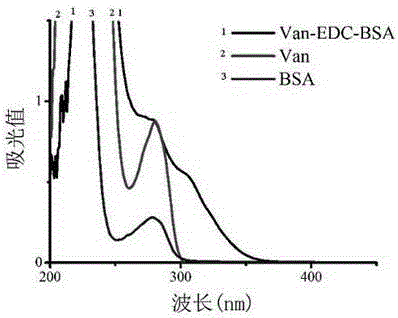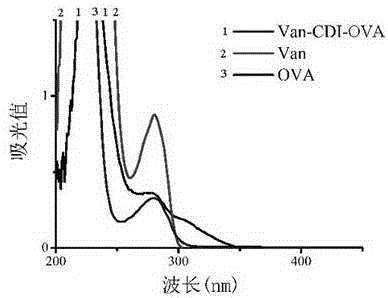Vancomycin-resistant monoclonal antibody hybridoma cell strain and application thereof
A technology of hybridoma cell lines and monoclonal antibodies, applied in the direction of anti-bacterial immunoglobulin, biochemical equipment and methods, material inspection products, etc., to achieve the effect of high detection sensitivity
- Summary
- Abstract
- Description
- Claims
- Application Information
AI Technical Summary
Problems solved by technology
Method used
Image
Examples
Embodiment 1
[0020] Embodiment 1: Preparation of hybridoma cell line 2A1
[0021] 1. Synthesis of complete antigen
[0022] Take 7.0 mg vancomycin hydrochloride, add 2.0 mg EDC and 1.0 mg NHS, dissolve with 400 μLDMF, 200 μL MES buffer, stir at room temperature, activate for 4 hours; take another 5 mg BSA and dissolve it in 2 mL, 0.05 M, pH 9.6 CB solution, The above-mentioned activated vancomycin solution was slowly added dropwise to the BSA solution, stirred at room temperature overnight, dialyzed at 4°C for three days, and stored at -20°C to obtain the immunogen. Dissolve 5mg of vancomycin hydrochloride in water, add freshly prepared 2.5mgNaIO 4 Aqueous solution, activated in ice bath for 30min, slowly add the activated vancomycin solution dropwise to 5mgOVA solution dissolved in 2mL, 0.05M, pH9.6 CB solution, react at 4°C for 2h, then add 0.5mgNaBH 4 , reduced at 4°C for 2 hours, dialyzed at 4°C for three days, and stored at -20°C to obtain the coating agent.
[0023] 2. Animal immu...
Embodiment 2
[0032] Example 2 Application of Anti-Vancomycin Monoclonal Antibody
[0033] The monoclonal antibody prepared by hybridoma cell line 2A1 through in vivo ascites was applied to the ELISA addition and recovery test of vancomycin, and the specific steps were as follows:
[0034] (1) Coat the 96-well ELISA plate with 0.5 μg / mL original coating diluted with carbonate buffer solution (CBS), 100 μL per well, after coating at 37°C for 2 hours, wash the plate three times with PBST washing solution, 250μL per well each time, 3min each time, pat dry;
[0035] (2) Block with CBS containing 0.2% gelatin, 200 μL per well, block at 37°C for 2 hours, wash the plate three times with PBST washing solution, 250 μL per well for 3 minutes each time, and pat dry;
[0036] (3) Prepare 0, 0.2, 0.5, 1, 2, 5, 10, 20ng / mL vancomycin in phosphate buffered saline (PBS); 0, 0.5, 1, 2, 5, 10, 20, 50ng / mL of norvancomycin standard solution. Add the standard solution and the extract of the sample to be te...
Embodiment 3
[0045] Example 3 Identification of subtypes of monoclonal antibody of hybridoma cell line 2A1.
[0046] Use the mouse monoclonal antibody Ig class / subclass identification enzyme-labeled secondary antibody kit to determine the subtype of the monoclonal antibody.
[0047] Table 12A1 Subtype Identification of Monoclonal Antibodies
[0048]
[0049] According to the test result of the kit, the subtype of the antibody is IgG2b.
PUM
| Property | Measurement | Unit |
|---|---|---|
| Ic50 | aaaaa | aaaaa |
Abstract
Description
Claims
Application Information
 Login to View More
Login to View More - R&D
- Intellectual Property
- Life Sciences
- Materials
- Tech Scout
- Unparalleled Data Quality
- Higher Quality Content
- 60% Fewer Hallucinations
Browse by: Latest US Patents, China's latest patents, Technical Efficacy Thesaurus, Application Domain, Technology Topic, Popular Technical Reports.
© 2025 PatSnap. All rights reserved.Legal|Privacy policy|Modern Slavery Act Transparency Statement|Sitemap|About US| Contact US: help@patsnap.com



